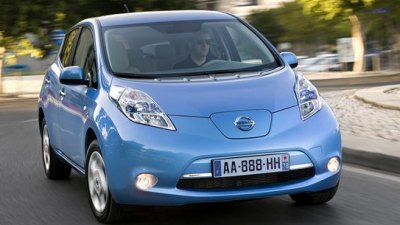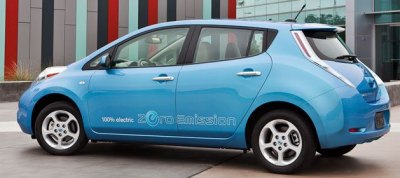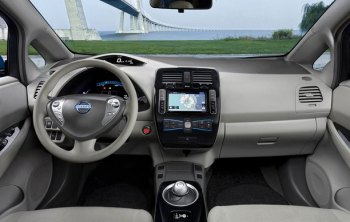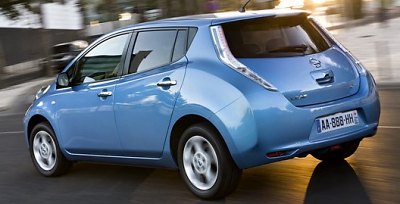Nissan Leaf
Debut: 2010 |
||||||||
Betting against hybrid cars, Carlos Ghosn wants his group to be the first to mass market electric cars. He estimates electric cars could take 10 percent of the global market by 2020, or 6 million units in annual sales. By 2012, he wants his companies to produce 200,000 units a year. A large part of them will be Nissan Leaf. Production has just started in Japan. Delivery is scheduled in December this year, first in Japan and USA, then in selected European countries from the first quarter next year. This mean the Nissan is going to be the world's first mass production EV, beating the much delayed BYD e6. Apart from Japan, production of the car and its battery will also take place in Tennessee of USA and Sunderland of UK, thanks to the generous incentives offered by local governments. You might expect an electric vehicle to be futuristic and unusual. In fact, Leaf looks and drives very normal. Outside, it appears to be just another family hatchback - well, the sealed nose might reveals its EV identity, especially when you open it and see a recharging socket, but that's all distinguishes it from conventional cars. Neither is its 0.29 Cd especially wind-cheating, as many hatchbacks these days may achieve 0.30 or better. Inside, apart from the software displayed on the instrument pod and satellite navigation screen, it all appears to be normal.
The Leaf is powered by a front-mounted AC synchronous motor capable of delivering 109 hp and 206 lb-ft of torque. Its power comes from 48 piles of Lithium-ion battery pack made by the joint-venture of NEC and Nissan. With a total capacity of 24kWh, it gives the car a range of 100 miles (160km), enough for most people to travel in a day. The battery packs are placed under the cabin floor and seats so to improve weight distribution and center of gravity. The power control module and DC-AC inverter are located under the bonnet. The on-board battery charger is situated between the rear seat and cargo space. Overall, the packaging of Leaf is neat and efficient. Being a family hatch, its 2700mm wheelbase is unusually long, more like a class above it. However, the interior space it provides is no more than conventional C-segment cars, because the extra wheelbase is mostly consumed by the charger. Both cabin floor and roof line are slightly raised in order to make room for the batteries, so the driving environment looks similar to that of MPVs. The boot measures a reasonable 330 liters, but sadly it is oddly shaped - deep but short. Fold the rear seatbacks does not realize a flat loading bay like its rivals. It is pointless to make the Leaf a hatchback. The high cost of Lithium batteries means Nissan has to cut costs elsewhere. The Leaf therefore rides on small-car suspensions - MacPherson struts up front and torsion-beam at the rear - so it is not supposed to match Golf or Focus for driving pleasure. The interior is packaged with hard plastics, though they are recyclable. The steering wheel is not adjustable for reach. The wheel itself and many switch gears come straight from the cheaper B/C-segment cars of Nissan, so the cabin quality does not match its price.
Nevertheless, for an electric car the Leaf is admirably affordable. In America, its list price is US$33,000, reasonable when compare to $41,000 for Chevrolet Volt and $28,000 for a top-spec Toyota Prius. Federal government will provide an incentive of $7500, and states like California will give another credit of $5000 for purchasing zero emission vehicles. This mean if you live in those states you pay only $20,500, which is comparable to conventional cars. In Britain, the government offers a grant of £5000, so the net price of Leaf will be £24,000. Very attractive. The question is: what if the incentives phase out ? Taxpayers cannot subsidize EVs forever, especially when debts are piling up quickly in Western governments. The Leaf would be impossible to survive by itself. All it can hope is the progress of battery technology will reduce cost quickly enough and the increased volume will drive unit costs down to economical level before incentives diminished. To me, this is quite doubtful. Mileage is another hurdles it has to overcome. Nissan said researches found 80 percent of the world's population travel less than 100km (62 miles), so the Leaf's 160km range will be more than sufficient. However, when you purchase a car you may also consider occasional long-distance tours, such as driving the whole family to country park for a weekend. Imagine what if your Leaf runs out of electricity and come to a stop in the middle of the wilderness. To avoid this, the Leaf has a clever navigation map which shows the area you are capable to go to, but this does not help making the purchase decision. Even in town, the lack of recharging stations in the foreseeable future is going to hamper its usability. Charging time is another problem. It depends on your charging facility. If you live in European mainland, your 230V 16A household socket will take a reasonable 8 hours to charge full its 24kWh battery. However, if you live in the 120V world, your home socket will take nearly 20 hours to do so, virtually making the car useless. Therefore you will need to purchase a 220V charger, which will reduce the time to 8 hours. In the future, Nissan hopes to set up recharge stations in big cities. With their 440V industrial power supply, the Leaf can be charged to 80 percent full in 30 minutes. However, such infrastructure is unlikely to be popular in the foreseeable future.
Less problematic is the way it drives. Although from spec. sheet the car looks slow, in reality it is satisfyingly brisk, thanks to the strong, 206 lb-ft of torque available right from zero rpm. Unlike internal combustion engines, electric motor does not need to gather rev to build torque. This make it shine in urban area. It is also smoother and quieter than conventional engines. On highway, the advantage fades as speed rises. The Leaf will run out of steam at 90 mph, whereas wind and road noise dominates the picture thus it sounds close to conventional cars. Keep it at that speed, its battery level will drop at alarming rate. It is better to drive relaxingly. Despite of the cheap suspensions, the Leaf does not ride badly. In fact, its soft setup, longer wheelbase and heavier than usual kerb weight delivers a big car feel. Only broken surfaces will generate more noise and shocks than desired. The handling is also similar to a conventional C-segment family hatch. The low center of gravity and less weight at the nose help it to steer into corners with surprising willingness. It's not a hot hatch though, because the low-rolling resistance tires give up sooner than keen drivers like. Also, the steering is light and lack of feel, and the brake actuation is abrupt, a typical problem for regenerative braking. Overall, its driver appeal is not as good as Chevrolet Volt. However, equipped with mass production electric car technology, Nissan has a chance to leapfrog pass Toyota as the green car leader in the world. Its success or not will depend on whether customers accept its shorter range and the need for time-consuming charging. One thing is for sure, the battle between the hybrid camp and electric camp will be intensified with the introduction of Leaf, Volt and the forthcoming plug-in hybrid Prius. No matter which wins, our planet is going to be benefited. |
||||||||
| The above report was last updated on 4 Nov 2010. All Rights Reserved. |
| Specifications | ||||||||||||||||||||||||||||||||||||||||||||||||||||||||||||||||||||||||||||||||||||||||
|
||||||||||||||||||||||||||||||||||||||||||||||||||||||||||||||||||||||||||||||||||||||||
| Performance tested by: *Autocar |
Copyright©
1997-2010
by Mark Wan @ AutoZine



